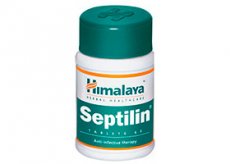Medical expert of the article
New publications
Preparations
Septilin
Last reviewed: 03.07.2025

All iLive content is medically reviewed or fact checked to ensure as much factual accuracy as possible.
We have strict sourcing guidelines and only link to reputable media sites, academic research institutions and, whenever possible, medically peer reviewed studies. Note that the numbers in parentheses ([1], [2], etc.) are clickable links to these studies.
If you feel that any of our content is inaccurate, out-of-date, or otherwise questionable, please select it and press Ctrl + Enter.

Indications Septilina
It is used in combination therapy together with bactericidal drugs for diseases affecting the respiratory tract, as well as for infections inside the oral cavity, middle or external otitis, infections in the urinary tract, diseases of soft tissues and epidermis of infectious origin, and for herpes (genital or common).
Release form
The product is sold in tablet form - 60 pieces per bottle. It is also produced in syrup form - in 0.1 l bottles.
Pharmacodynamics
The drug is used as an auxiliary, in combination with antibacterial agents, in the treatment of infections of various origins. Combination with antibiotics reduces the duration of their use, accelerating the recovery process. The drug stimulates phagocytosis and activation of macrophages, and at the same time increases the number of polymorphonuclear cells.
Septilin has a powerful anti-inflammatory, bactericidal, adaptogenic, diuretic, immunomodulatory, and antihistamine effect. Strengthens the body's immunity to infections. The medicinal effect develops by increasing cellular cytotoxicity, as well as the activity of killer cells.
Stimulates humoral immune response, resulting in an increase in the size of antibody-forming cells, as well as increased release of antibodies into the bloodstream. The drug increases the number of erythropoiesis precursor cells with granulopoiesis, as well as band-shaped leukocytes and myelocytes. Septilin also has a strong wound-healing effect.
The therapeutic properties of the drug are due to the effects of its constituent elements:
- guduchi, which has a strong immunomodulatory and immunostimulating effect - helps to activate the activity of macrophages, increase the antibody level, and also enhance the bactericidal and phagocytic properties of neutrophils. Together with amalaki, this element has an antipyretic effect. All this contributes to the treatment of such diseases and disorders as bronchitis with pharyngitis, laryngitis and chronic tonsillitis, as well as nasal congestion;
- Myrrh gum is an extract of chloroform - like other essential oils, as well as sesquiterpenoid compounds, it has a wide range of antibacterial effects;
- Moringa oleifera - has a strong antipyretic, anti-inflammatory, diuretic, and antispasmodic effect. In addition, it slows down the formation of lipid peroxidation products;
- licorice - contains a combination of flavonoids, which allows it to have an anticholinergic and antihistamine effect, as well as soften the cough. In addition, it contains the element glycyrrhizin, which can increase interferon levels and stimulate the production of cortisol. At the same time, it has antiviral, hyposensitizing, anti-inflammatory and adaptogenic properties, eliminates toxins from the body, stabilizes blood sugar levels and enhances the protective function of the gastrointestinal mucosa;
- Amalaki - increases the production of interferon, as well as phagocytosis, and in addition, enhances cellular resistance;
- Maharasnadi kwat, which contains essential oils with flavonoids, has an analgesic and antipyretic effect;
- shell powder, which contains calcium, is an antioxidant and reduces the severity of irritation of the gastric mucosa.
High medicinal effectiveness is ensured by the correct balance of all the constituent elements of the drug, as well as their mutually potentiating effect.
Dosing and administration
The medication should be taken in combination with other antibacterial drugs, without regard to food intake.
Taking the drug in tablet form.
For adolescents over 12 years of age and adults – take 2 tablets twice a day for 21 days. For children aged 6-12 years – take 1 tablet twice a day.
Syrup usage mode.
For adults and adolescents aged 12 years and over, the serving size is 10 ml, taken 2-3 times a day. For infants aged 6-12 months – a quarter of a teaspoon. For children aged 1-2 years – 0.5 teaspoon. For the age group 2-5 years – the serving size is 1 teaspoon. For children aged 5-10 years – the dosage size is 1 teaspoon twice a day. For the age category 10-12 years – 1 teaspoon three times a day.
Use Septilina during pregnancy
Septilin should not be used during pregnancy.
Side effects Septilina
Occasionally, the use of drugs may contribute to the development of local signs of allergy (in the form of rashes on the epidermis and itching).
 [ 11 ]
[ 11 ]
Shelf life
Septilin can be used within 36 months from the date of manufacture of the drug.
Application for children
The drug in tablets is not prescribed to persons under 6 years of age.
 [ 19 ]
[ 19 ]
Attention!
To simplify the perception of information, this instruction for use of the drug "Septilin" translated and presented in a special form on the basis of the official instructions for medical use of the drug. Before use read the annotation that came directly to medicines.
Description provided for informational purposes and is not a guide to self-healing. The need for this drug, the purpose of the treatment regimen, methods and dose of the drug is determined solely by the attending physician. Self-medication is dangerous for your health.

